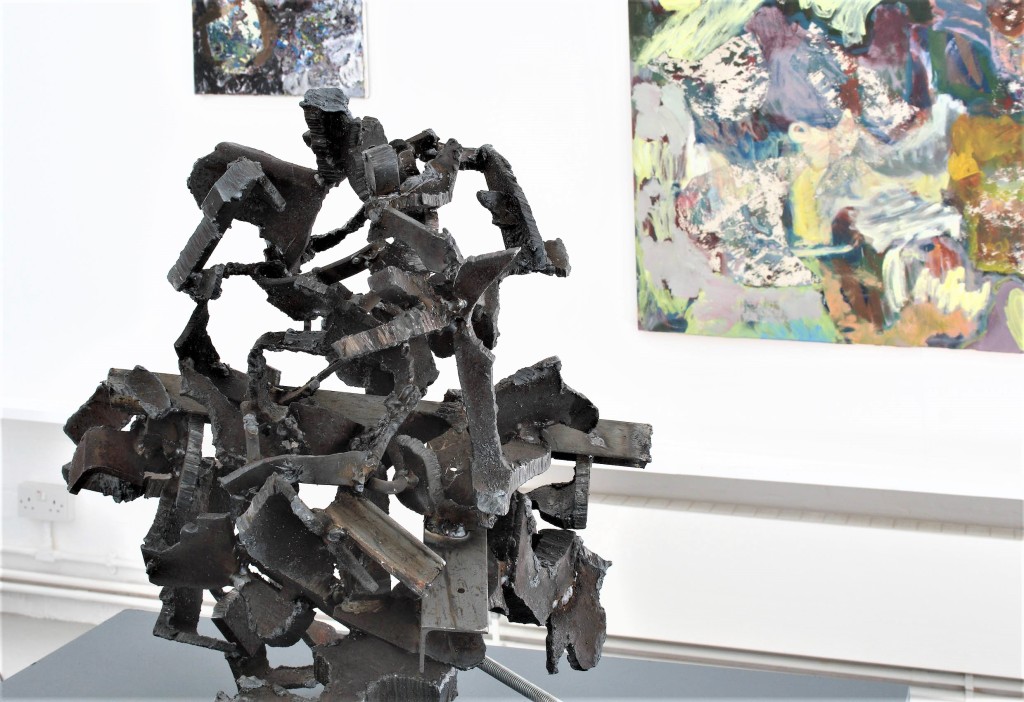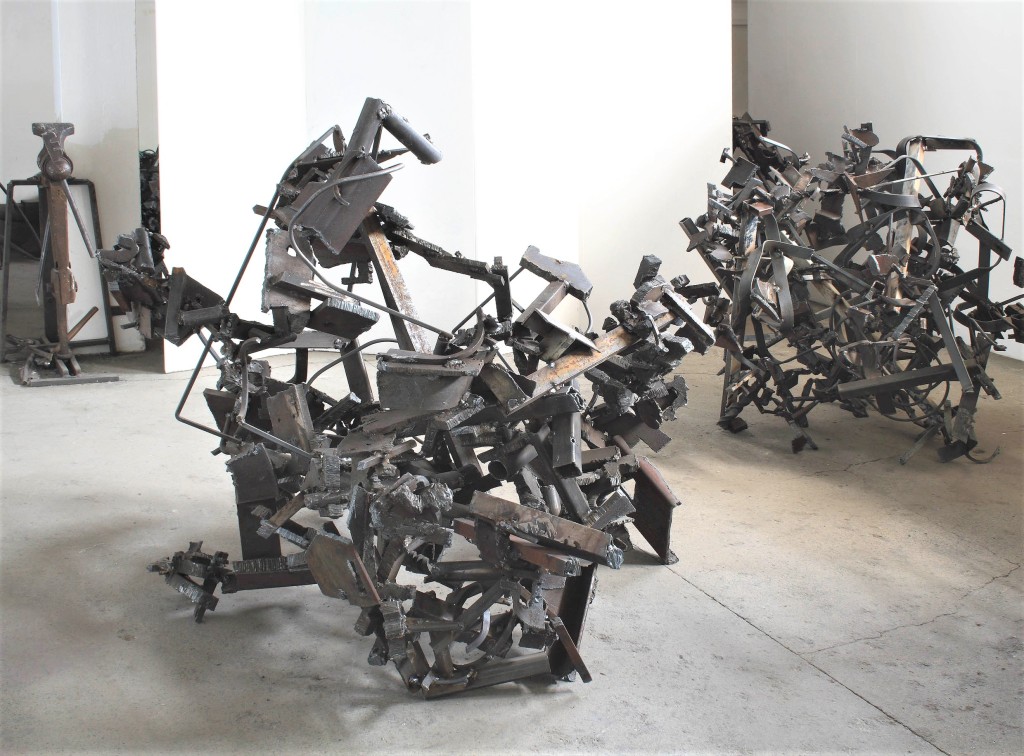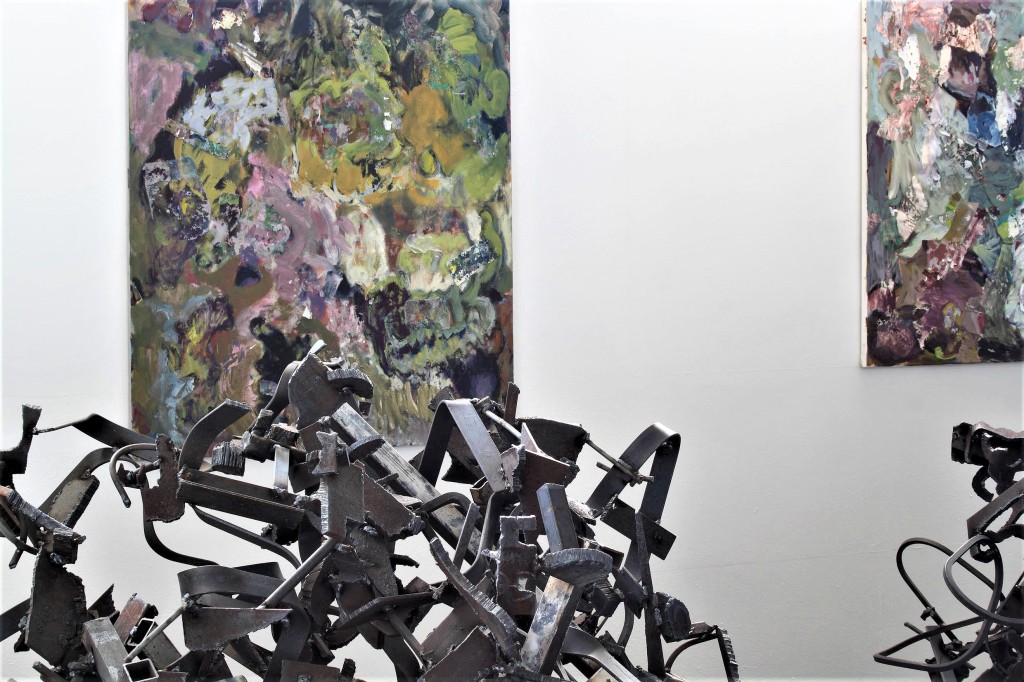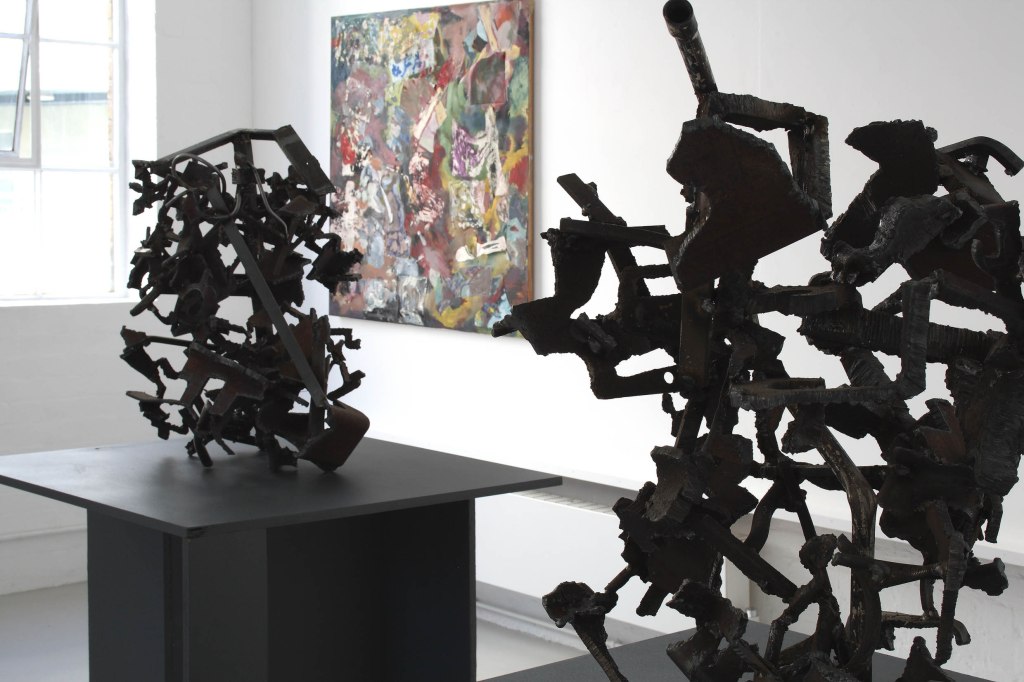
abcrit.org, Block K, 13 Bell Yard Mews, 175 Bermondsey Street, London SE1 3UW
Exhibition opens Monday 11th July 2022.
Visit by prior appointment, preferablyThursday-Sunday, 2-7pm, or by other arrangement.
Text your name and requested date and time to 07866 583629, for return.
The entrance to Bell Yard Mews is opposite White Cube in Bermondsey Street.
Block K is at the rear of the mews: the gallery is on the 1st floor, no lift.
This is the ninth exhibition of abcrit.org
…

…
The works in this exhibition have no beginnings or endings of any variety of subject-matter, figurative or otherwise. Nor do they have clear definitions of meanings or motives that I can tell about. But in going through numerous modifications, seemingly of a partially accidental nature, the work moves towards something of a rather wild (that is, unexpected) invented wholeness, discovered at particular moments.
And those “moments” are hard to identify, as real things about real abstract art are further revealed. Now we know abstract art is not about simplification. We know too that images are not a part of the reality we seek. We know that ideas are, like as not, a waste of time. We are, I hope, some way past such things as these. And we know that complexity is an integral part (but only a part) to the expansion of abstract content, even as we don’t quite know what that means.
On the whole, there is good progress, despite the difficulties.
…

…
The sculptures and paintings on show are as follows:
On the 1st floor gallery (abcrit.org) are seven sculptures (on bases) and thirteen paintings.
On the ground floor (normally my studio) are seven larger sculptures and seven paintings.
All these works are from 2019-22. For the most part, they have no titles, and I have recently begun to avoid or forget about them.
Whilst posting a few photos of this exhibition here to provide a reasonable expectation of what the show in general looks like, I have bid to avoid too many images that pretend to take the place of being in front of the work; or rather, being around and about it. I include in that essential activity the paintings as much as the sculptures, in which their own kind of full three-dimensional content is attempted out of necessity.
Robin Greenwood
July 2022
…

…

…

…

…

…

…
With thanks to all who have contributed to previous abcrit exhibitions, whether in showing work or just coming to look.
R.G.
Reblogged this on EC.
LikeLike
Robin, I look forward to visiting again. This show is a serious antidote to limp abstract shopping that seems to be doing the rounds. I hope many people take the time to really look and consider. Best, EC
LikeLiked by 1 person
Thank you EC.
LikeLiked by 1 person
There is a discussion on Vimeo with me interviewing Frank Bowling, made ten years ago at Tate Britain. I thought it was lost, but it is on film at Bowling’s show in Greenwich at the moment. Some of the questions I raised with Frank back then are still relevant, I was surprised to find.
See it on Vimeo here: https://vimeo.com/47727286 (I think you have to join/log in).
LikeLiked by 1 person
Hello Robin. I found if I waited, the “sign up” to vimeo thing vanished and the video popped up and would play. Didn’t have to join. Listening to it when I get in tonight. Looking forward to it. Only caught snippets at the pv due to noise.
LikeLiked by 1 person
Robin, I’ve been thinking about your interview with Frank Bowling (The poured paintings – Frank Bowling at the Tate 2012) and both your show and his. There are important differences to talk about regarding how the two of you approach painting and sculpture. What do you think? It’s a bit of luck these shows are on at the same time.
I’ve only seen your show once (I’m coming back next week though) and Bowling’s once, in a busy pv setting so that’s not ideal. I imagine more will come to mind on my next visit to these shows.
In the meantime – There’s a dialogue to be had re the relationship between sculpture and painting, in both your cases but also in a broader sense. In the talk at FB’s show someone referred to quotes about his paintings as being “sculptural” ( – from public or critics? Not sure).
So there’s a problem right there. Describing the paintings as “relating to his sculptures” is different to calling them “sculptural paintings”. Which they’re not, right?
Can you tell me more about this re your own work and the idea of ‘3 dimensionality’ versus ‘sculptural’ when talking about your painting and sculpture?
I wonder if some people use the phrase ‘sculptural paintings’ as soon as something protrudes from the picture plane? Whereas the relationship between the paintings and the sculptures (in FB’s case) might be to do with a more hidden structure within the paintings. That seems to be more worth thinking about. So “Sculptural paintings” = red herring. Anyway, the contrasts with your work were there and I thought worth a bit of digging. Discuss! 🙂
Oh also re “found geometry” (FB mentioned in interview) – it’s inevitable as we go through the process of organising our work. I think geometry can always be projected onto/read into painting – no matter how “found” and searched out that might be. Especially when painting within a rectangle – instant geometry to deal with. Even a return to hidden classical geometry might be there, unconsciously brought about – as in the Golden Section etc. (Bowling suggests in interview it’s not classical geometry….but…). I mean, classical ideas about beauty and harmony might be there within the found structure that some painters might settle on with “finished” decision – instinctively. I think I could go as far as to say that Wragg messes with that instinctual, found, underlying geometry and underlying classical stuff and the eye/brain knows it….? Geometry is always there because we’re dealing with arrangement in/on a space. Even decisions of where to leave a pour – chance is chance but it’s happening within parameters and with intuitive moves that come from a rich seam of visual learning (I mean the poured paint isn’t in the car park is it) and other decisions around it or cropping will all add to the pulling back from a chaotic soup. It’s not mapped out initially in the kind of work we make, but that doesn’t mean it’s not there. It can be incredibly instinctual and perhaps that is another word for ‘found’. This ‘found geometry’ has a lot to do with why we think something ‘works’ even in the seemingly most ‘chaotic, messy’ (not) painting ie complex. Back to Wragg – he jolts that so much, when he’s really good, that it pushes those buttons that might desire something different… our sense of discombobulation at visual imbalance and then teetering on the edge of coming back together again. Why not propose that? Instead of going for the known wholeness and all-overness or some kind of habit. Am going off on tangent. I think there are interesting decisions in some of your work that go there too though….you know, when someone says “If that corner had something it would hold together”…but what if that isn’t an error but a proposition to think about things differently?
Exciting stuff. Looking forward to a long, good look at your show. I need more time with the work and to think…so we can discuss it more too…
LikeLiked by 1 person
I think more than ever about how meaningful new painting could work with a degree of three-dimensionality, and thus attempt to “go after” what my sculpture generally tries to do. Actually, I’d say sculpture can go after something more than three-dimensionality – maybe three-and-a-half-going-on-four-dimensions, involving as it does (to put it crudely) the time and movement involved in advancing and returning etc., round and about the work. Painting cannot involve itself with quite that same approach. Nevertheless, I want to go that way (i.e., in “shaking” times, in and out)…
So the Frank Bowling “Poured Paintings” that I filmed with him in 2012 are works that I admire still, but like many of the sixties/seventies/eighties American abstract paintings, or the British abstract sculpture from that period (Caro etc.), I no longer feel connected to them. Been there, got the tee-shirt, and it shrunk in the wash and can’t be worn by me (maybe others?). The simplistic frontal geometries of most of those works, sculpture and painting, have had it for me; they are the kinds of work I cannot continue with.
Likewise with the Bowling sculptures in his show (some of which I myself chose to show at Poussin Gallery in 2010); there is little left of much interest now, especially (and obviously) when the work is frontal/two-dimensional (see Caro again!). We are now, like it or not, at the point where abstract art must move on – for better or worse, but it must move on. The place to move on to is heavy-duty, complex three-dimensionality. There is no point in abstract sculpture and painting emulating, or connecting with, pictures, ideas and images. Leave that for the computers. They may kill abstract art anyway, if we let them.
The best of figurative paintings – like Tintoretto or Cezanne, say – are very much involved with three-dimensional spaces and how they can be built to exist together in the three-dimensional content of two-dimensional illusion. New figurative art has none of that now, for complex reasons we might go into another time.
Will spatial, three-dimensional content work in abstract art? I think so, but it’s a struggle. As I’ve said many times, complexity is very important, but it will not, by itself, solve all the issues.
One last thing – anyone who describes thick materials frontally stuck onto paintings as “sculptural” is talking ballcocks…
LikeLiked by 2 people
….met up with Alex on our visit to this show
So … Robin ,Tony, Alex, Sarah and
myself spent some time discussing Robin’s work in great detail .
A reminder , if one were necessary, of the real value of debate . With the exchange of thoughts and feelings in those moments , with a mutual respect , more understanding of Robin’s sculpture and painting naturally unravelled . We enjoyed this VERY much…. .an exciting visit.
… absolutely enhanced by The volume and The quality of Robin’s abstract decision making .
Anne and Tony
LikeLiked by 2 people
This show is excellent. The strong, somewhat brutalist, sculptures have dynamic contrasts, accented linear structure holding and coursing through tumultuous moving elements within and out. There is a constant sense of powerfully charged visual sensation with change and movement as you walk round them. Fantastic!
The paintings have rich, deep, complex colour. They also have this sense of shift and change especially when viewed from different angles and distance.
The whole experience is completely enriching.
LikeLiked by 1 person
Noela,
Great to see you and Mark yesterday. Many thanks for your visit and very encouraging comments.
LikeLiked by 2 people
Still thinking about Robin’s sculptures…in the sense that they’re so complex & ‘shifting’, working out, creating space, or in motion somehow, that after even hrs with them & a few visits, I turn to take one in again & it appears shockingly different!
LikeLike
I don’t know whether this is true or not, but… could it be that the changes to visual activity that seem to operate in some of the sculptures (especially the big ones) when you look a second/third/further time are to do with a truer abstract-ness. What I mean by this is that you don’t come to the end of a “story” in the work, but it stays open-ended? This is a massive difference from how abstract art has been previously thought about. You can’t walk away thinking you have in your mind the content… We all do this, of course, but maybe we should get away from such an approach to looking at abstract art. Re-think needed?
If it is true (to some extent), I’m all for it, and interested in those characteristics developing more in both the sculpture and the painting. And again, I’m still thinking that complexity is not everything, but not nothing either. What is the complexity “working on”?
LikeLiked by 2 people
I have been thinking about what EC has written regarding how Robin’s sculptures shift, create space or are in motion, and I have very similar sensations to EC when I have been present in front of one of Robin’s sculptures and I would suggest most of us do when looking at them.
I feel the object has transmitted something which on the next viewing (of being in the same place, looking at the same view) cannot do again. the work has done its job. It cannot transmit to me again what it has already communicated and I have been changed by the object. The work, offers me a glimpse of its content, not all of it, so I move position and I find more. It is alive and changing.
LikeLiked by 2 people
The complexity acts upon, or with, the structures of the work, enhancing the three-dimensions in space. Sometimes (often?) you need to rip out some of the complexity when it’s not acting correctly on behalf of the content as a whole. Then it becomes a complication. But how and when to guess that act? Complexity is very close to complication, and vice versa.
Here is an interesting (and complex) thought – what part goes gravity play in abstract sculpture and painting?
And time! How do we get time to work in abstract painting? I’ve already mentioned time in the act of looking at/moving in sculpture. How about in painting? It’s in there, no?
LikeLiked by 2 people
Yes, I think there can be shifting and movement when looking at abstract painting, three dimensionality and motion can become apparent with changing light and looking from a distance or side angle.
Not as great as in abstract sculpture but still possible to some extent.
LikeLike